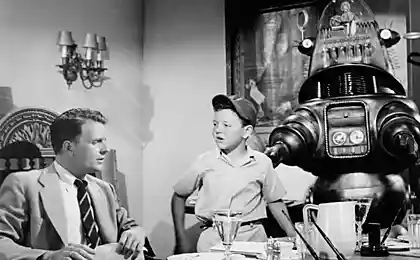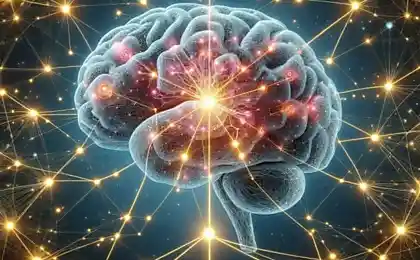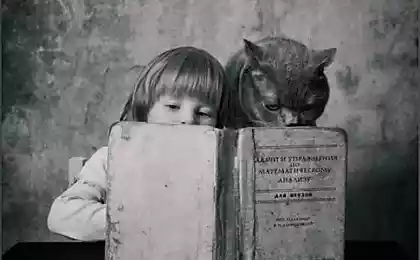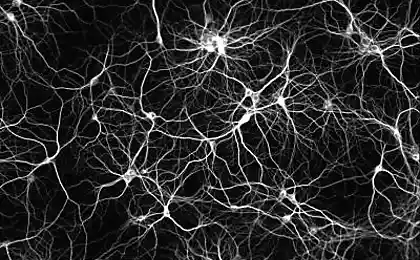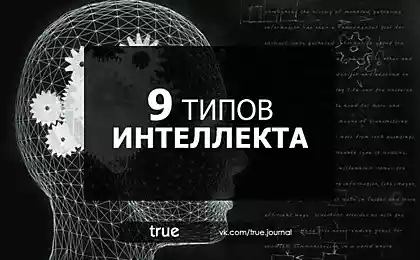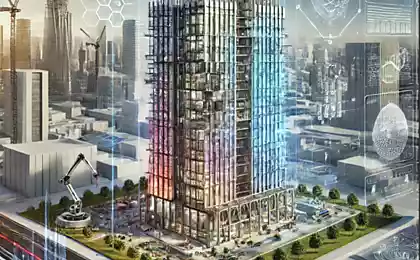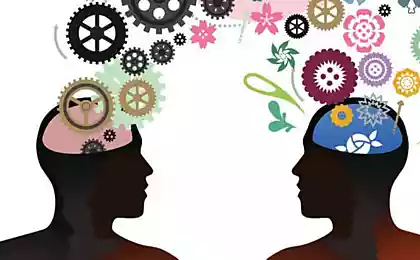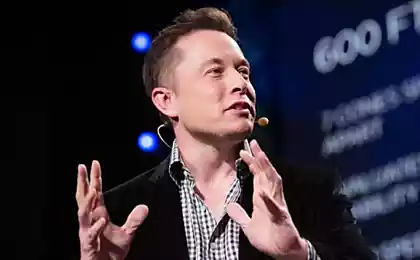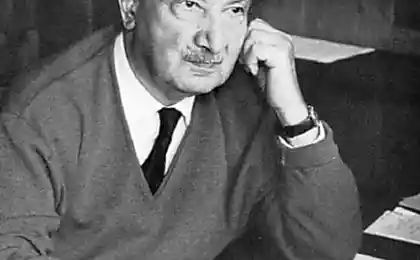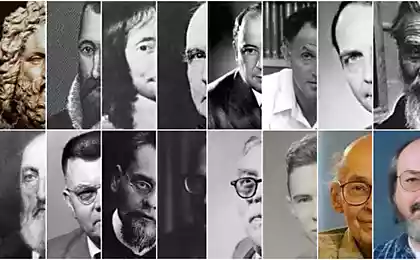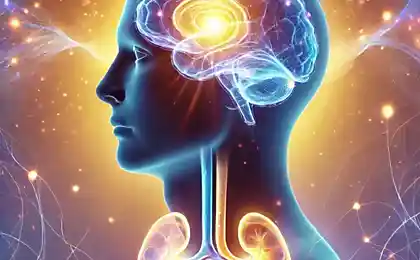1752
The logic of thinking. 15. Part of memory consolidation

This series of articles describes the wave model of the brain, is very different from traditional models. We strongly recommend to those who just joined, to start reading from the first part of the .
Try to imagine the information capacity of the brain. Since neurons are the basis of memory, to begin with let us specify how many neurons we are dealing with. The most accurate estimate to date, belongs to Suzanne Herkulano-Huzel (Frederico AC Azevedo, Ludmila RB Carvalho, Lea T. Grinberg, José Marcelo Farfel, Renata EL Ferretti, Renata EP Leite, Wilson Jacob Filho, Roberto Lent, Suzana Herculano-Houzel, 2009 ). For this assessment on the cortex account for 82% of the total weight of the brain and 19% of the total number of neurons (shown below). For this assessment crust consists of about 16 billion neurons (1.6x10 10 sup>).

The number of neurons in different parts of the brain (in billions) (Frederico AC Azevedo, Ludmila RB Carvalho, Lea T. Grinberg, José Marcelo Farfel, Renata EL Ferretti, Renata EP Leite, Wilson Jacob Filho, Roberto Lent, Suzana Herculano-Houzel 2009) i>
In models that use the plasticity of synapses to explain the nature of memory, the memory capacity is considered to be quite simple. Characteristic for the neuron synapses - 10 000 (10 4 sup>). If we assume that one synapse stores one bit of information, it turns 1.6x10 10 sup> x 10 4 sup> = 1.6x10 14 sup> bits or approximately 2x10 13 sup> byte. It is about 20,000 gigabytes or 20 Terabytes. Volume rather modest, even by today's standards.
Assuming that the active life of a man about 80 years, from which he holds a third of a dream, it will be 80x365x (24-8) x60x60 = 1681920000 (1.7x10 9 sup>) seconds. It turns out that if you do not take into account the organization of memory, and just fill it in their lifetime, it is possible to let the recording speed 2x10 13 sup> /1.7x10 9 sup> = 1.18x10 4 < / sup> byte / second, or about 10 KB / sec.
In our model estimate the amount of memory is somewhat different. Estimation of synaptic memory does not change, the same 20 Terabytes. But this is just a memory, storing images of neurons-detectors. The main volumes fall on receptive extrasynaptic clusters. If a given estimate that one extrasynaptic image is formed from the signals of the order of 100 synapses, we can estimate the information capacity of one element is 100 bits. Based on the assessment that the surface of the neuron may contain about 100,000 receptive clusters obtain capacity 1.6x10 10 sup> x10 5 sup> x100 = 1.6 x10 17 sup> bit or 2x10 16 sup> byte. That makes 20 000 terabytes or 20 petabytes.
Assuming that half of this memory is spent on the bark of propagating waves IDs, the volume of event memory can be estimated at 10 petabytes. This causes a certain amount of respect. Based on it, the speed of recording information in a continuous memorizing may be 10 16 sup> /1.7x10 9 sup> = 5.88x10 6 sup> byte / second, or about 6 megabytes / second. Assuming that the fixation engrams occur several times per second, it is possible to assess the information capacity of one engrams around 1 megabyte.
Potentially, our memory is able to store a sufficiently detailed description of everything that happens to us in life. The totality of memory supported by the presence of people, phenomena that are really "remember everything". Alexander Luria as a result of long-term observations documented one example of such an infinite memory:
"It was found that the memory Sh no clear boundaries, not only in volume but also in strength retention traces. Experiments have shown that it is a success - and without significant labor - can play any long series of words given to him by week, month, year, many years ago. Some of these experiments invariably ended in success, were carried out after 15 - 16 years (!) After the primary series and the memory without any warning. In such cases, S. sat down, closed his eyes, paused, and then said: "Yes, yes ... it was you on the flat ... you were sitting at the table, and I'm shaking ... you were in a gray suit and looked at me ... here ... I see what you told me ... "- and should continue to play error-free reading series" (Luria, 1968).
But no matter how our memory was boundless, well aware of the fact that it is much easier and more detail, we recall the recent events. Even in 1885, a psychologist Hermann Ebbinghaus forgetting curve was obtained (Ebbinghaus, 1885) (see Figure below).
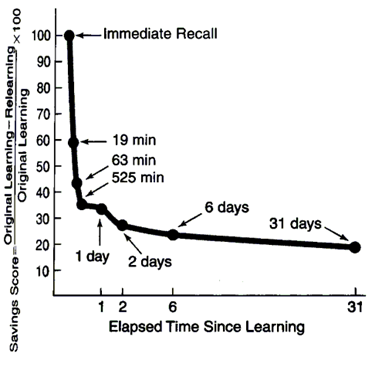
forgetting curve i>
The sharpest forgetting observed in the first minute, then slows down the process of forgetting. After 30 days, the memory goes to the stable phase when further forgetting occurs. In their experiments, Ebbinghaus used a set of meaningless three-letter words that are memorized. Memorizing is somewhat different from the simple perception, that is, forgetting curve for once heard a phrase or an image seen is somewhat different.
Remember that a stronger allowing repetition. Repeating the material, we do not just refresh the memories and start a new cycle of forgetting. After repeating, asymptote, which goes forgetting curve rises significantly higher than its previous level (see Figure below). Each new iteration increases the chances that, after a long time, we are able to accurately recall all relative.

forgetting curve with repetition i>
It is important to note that repetition is not necessarily confined to another presentation to memorize the image. Recollection, accurately reproducing the stored event as a repetition. That is, the more often we remember something, the stronger it cuts into our memory.
The traditional interpretation of the properties of the memory is based on the idea of transferring memories from short-term memory into long-term memory. It is often based on computer analogies storage imply the movement of information from one trace to other parts of the brain. So it is assumed that the hippocampus, working like a computer's memory, stores the current memories, and then moves them to bark, similar to how the preservation of computer data on durable media.
The process of moving memories from short-term to long-form called memory consolidation. This is an objective and sufficiently well-studied process. In addition, we can observe changes in memory to my own experience, there is a direct confirmation of the presence of consolidation. Since it is known that a head injury, electric shock, seizures interfere with the normal memory formation. They call retrograde amnesia, where memories related to a certain period of time preceding the crash, are lost.
A similar effect is obtained when memory loss introducing substances into the brain, blocking the expression of certain genes that produce the proteins involved in the work memory.
In addition, the effect of retrograde amnesia is familiar to many of significant memory loss after excessive alcohol consumption. Determination of the critical dose is so drunk alcohol disrupts the consolidation of that part of the memories completely erased, creating irreparable failure of memory. Thus there is no loss of the ability to memorize the current is in violation of the hippocampus, namely the erasure of memories already received, or rather do not translate them into long-term storage phase. A patient with Korsakoff's syndrome loses the memory as soon as it switches its attention. The man who had been drinking a critical dose, still remembers the recent events, and in many cases can support related conversation. However, the next morning all the memories from a certain point, are erased.
To explain the effect of consolidation necessarily close to the computer analogy associated with the physical movement of the data. In our model, the consolidation and its meaning can be described as follows. As we said earlier, extrasynaptic metabotropic receptive clusters have the effect of hysteresis. This means that if the neuron generates a spike, then racing membrane potential under certain conditions, as described earlier, can serve as a pretext to go receptive cluster to a stable state. Steady state - it is a state in which the end portions of the receptor from the membrane and pushed the receptor becomes sensitive to a specific signal, or the state of their drowning in which the receptor, on the contrary lose sensitivity. This change occurs with receptive clusters for which the conditions of interference of mediators from surrounding synapses, that is, which are tuned to a certain image.
Daylight receptive clusters in such a state occurs while a huge number of neurons are active at the current time. That means that the current remembered with extreme redundancy and detail. This leads to the fact that other things being equal, the current events are much more likely to be remembered than events more distant in time.
This giperpodrobnuyu memory can be called operational or short-term memory, but do not confuse it with the current and wave-induced activity of cortical neurons. The activity of neurons forms the description of what is happening, as short-term memory stores the picture of relatively recent states. Moreover, short-term memory does not differ from the rest of the memory, except that fresh memories are more detailed, as they use significantly more receptive clusters than other engrams.
Duration of cache memory - seconds. Then, most of the receptors extrasynaptic reset, finding new willingness to engage in acts of remembering. But a substantial part of the receptive clusters one reason or another is able to fix the image. They go to the next stable phase, which allows them to continue to exist and therefore keep a fragment of his memories.
We can assume that every memory undergoes several stages of consolidation, losing at every stage part of its receptive clusters. The simplest algorithm forgetting - probabilistic. Adjusting the probability of a cluster receptive of the next stage of consolidation, you can get the required amount for each memories by the time of his move to long-term memory.
Accompanied by a consolidation phase synthesis advising proteins which determine the total for all processes. The course for the consolidation of metabotropic and ionotropic receptors is different, but quite similar ideologically. Immediately after the training begins in the nucleus of the neuron expression of immediate "early genes." These genes encode transcription factors. Transcription factors trigger the transcription of the "late genes". Indicative timetable of this procedure is shown in the figure below.
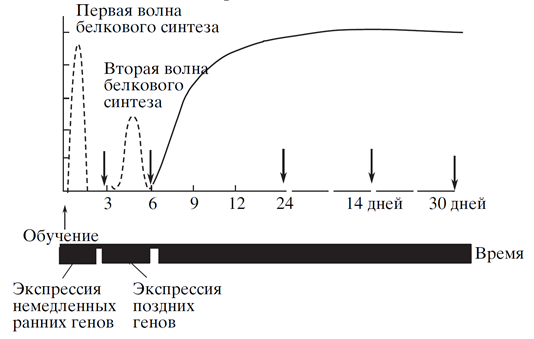
The expression "early" and "late" genes (EV Muravyova KV Anokhin, 2006). i>
There are different proteins for which proved their involvement in memory formation. Arc, CPEB, Kibra - is only a small part of them, although the most frequently mentioned. It must be remembered that information leaves traces of two types of neuron. One is related to the change in the sensitivity of its synapses, with other changes in the fixation extrasynaptic receptors. The first effect on the properties of the neuron as a detector. The second provides the ability to spread the wave of neurons identifiers stored event-memory associative form, and the like. How and in what sequence occurs protein regulation of these processes is not a simple question and yet having no generally accepted answer is because there is no universally accepted model and memory. Therefore, in our model, we will focus on a common ideology process, unfortunately, is not the name of the opportunity to describe their demonstrative protein regulation.
Consolidation actually sets a timer that counts down the stage of life elements memories and regulates the probability of transition to the next phase. We can assume that the repetition of the experience that is equivalent to or recollection of it, change the course of consolidation, increasing the chances of receptive clusters on the transition to a phase of long-term memory. That is, the more repetitions, or more often the memories, the more significant the event leaves a trace. And the higher the probability of recovery with the appropriate information request.
Since the emotionally significant events make us more likely to remember them, compared with neutral events, this could be one reason why emotive events form a strong and stable traces in our memory.
But memories of the lived experience is not as simple as they seem. Psychologists have long known phenomenon of the transformation of memories. His first shown in 1932 Frederic Bartlett (Bartlett, 1932). He found that if a person is remembering a specific event, add any details, the memory of the original is replaced by the new and changed items are part of this new memories. And people are not aware of these changes and said that everything was exactly as he remembers today. Such a change is called reconsolidation of memories memory.
Reconsolidation of memory fits into our model. The memory of any event is accompanied by the restoration of its unique identifier. If for any reason, the distortion of the original memory, the current stored image information with the same identifier as the main memory, since this identifier is present in the space of the cortex. So, inevitably occurs Bartlett described the phenomenon of transformation.
There are very interesting experiences that show that reconsolidation may be accompanied by not only a transformation, but also the erasure of memory. But because these experiences are more relevant to behavior than to the memory of event we will look at them later in the relevant section.
The general ideology of event memory can be described as follows. The incoming information creating fresh memories with great redundancy and detail. This makes them extremely affordable for online access. This memory does not live long. She memory undergoes consolidation phase, each of which reduces the amount of receptive clusters forming engrams. As a result of the consolidation phase going on, apparently, about a month engrams become stable volume and move into a phase of long-term storage.
Previously, we estimated the amount of the order of event brain memory 10 petabytes. Location Roma brought by engrams estimate of the size of 1 megabyte. This assessment may be true for the old, past all the stages of the consolidation of memories. Most of the information with which we operate, refers to the current day. For this detailed information is provided by redundant storage. It can be assumed that such a current memory takes a significant amount of the total memory of the brain. If I was the designer of the human brain, I would have empirically took on fresh memories of half the available memory, and the remaining half placed under the old memories.
In this empirical assumption that the speed of recording information the brain can be estimated as 5x10 15 sup> / (16x60x60), which is about 10 11 sup> bytes or 100 gigabytes per second. Of course, this is much more than the entire amount of information coming from all the senses together. But the conversation is not about the amount of input and on the detailed description, consisting of a set of descriptions appearing in each of the areas of the cortex.
In this initial estimates the size of one engrams be about 10 gigabytes. Actually, the process of memory consolidation - is the gradual reduction of this extremely excessive volume to a level of about 1 megabyte.
Nevertheless, however not really been the volume ratio of the old and new memory nature should optimize it so to avoid unnecessary idle backup volumes. This means that, given the extremely high speed recording of current information, may come a time overrun all of the available memory. We can assume that sleepiness - this is a condition where the brain information resources suited to its filling and cleaning of memory is required.
In principle, the operational memory consolidation happens all the time, continuously compressing volumes of engrams, the brain provides space for new memories. But we can assume that the operational consolidation of a number of disadvantages. So in our model neurons detectors form patterns corresponding concepts. Each concept defines a plurality of patterns in different locations of the cortex. To pattern launched a wave, a substantial portion should be activated neuronal pattern.

